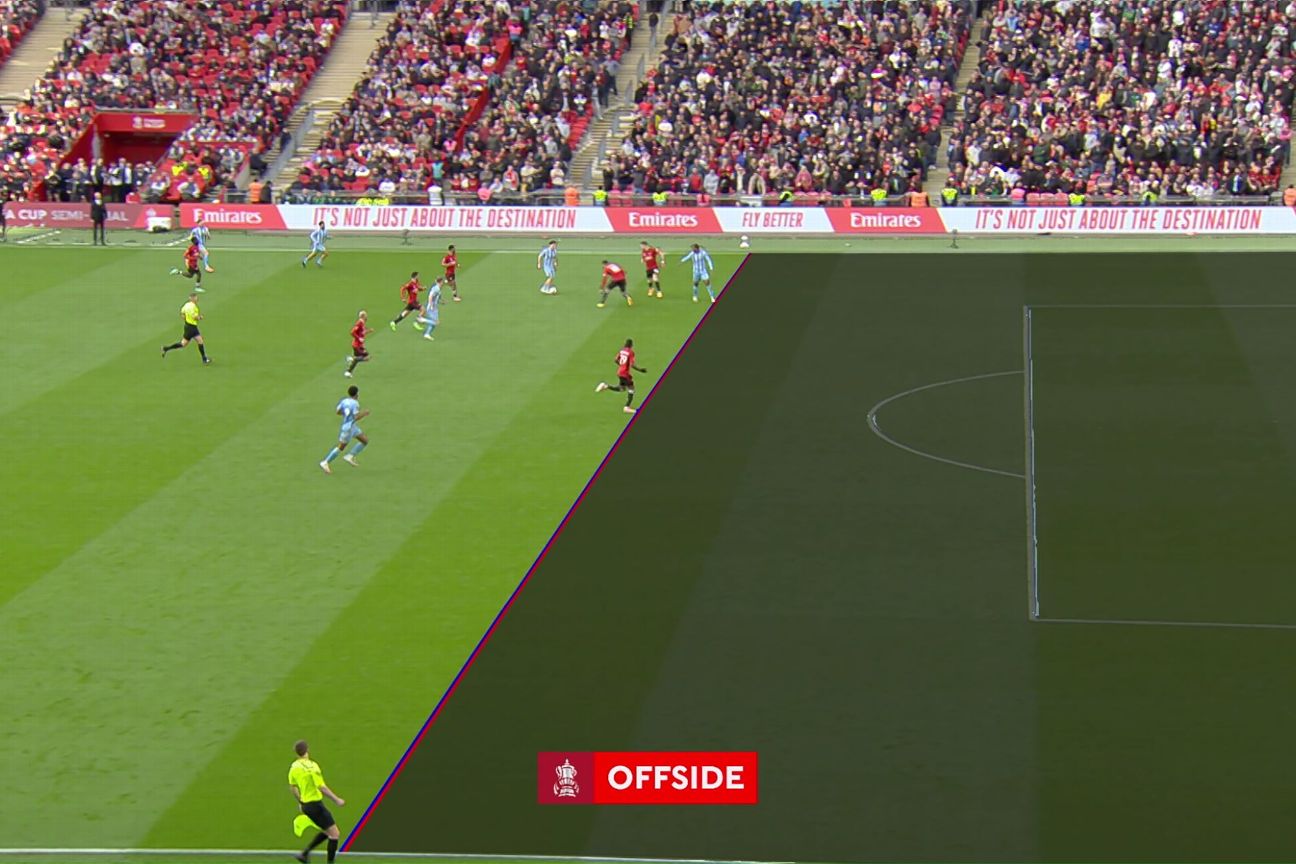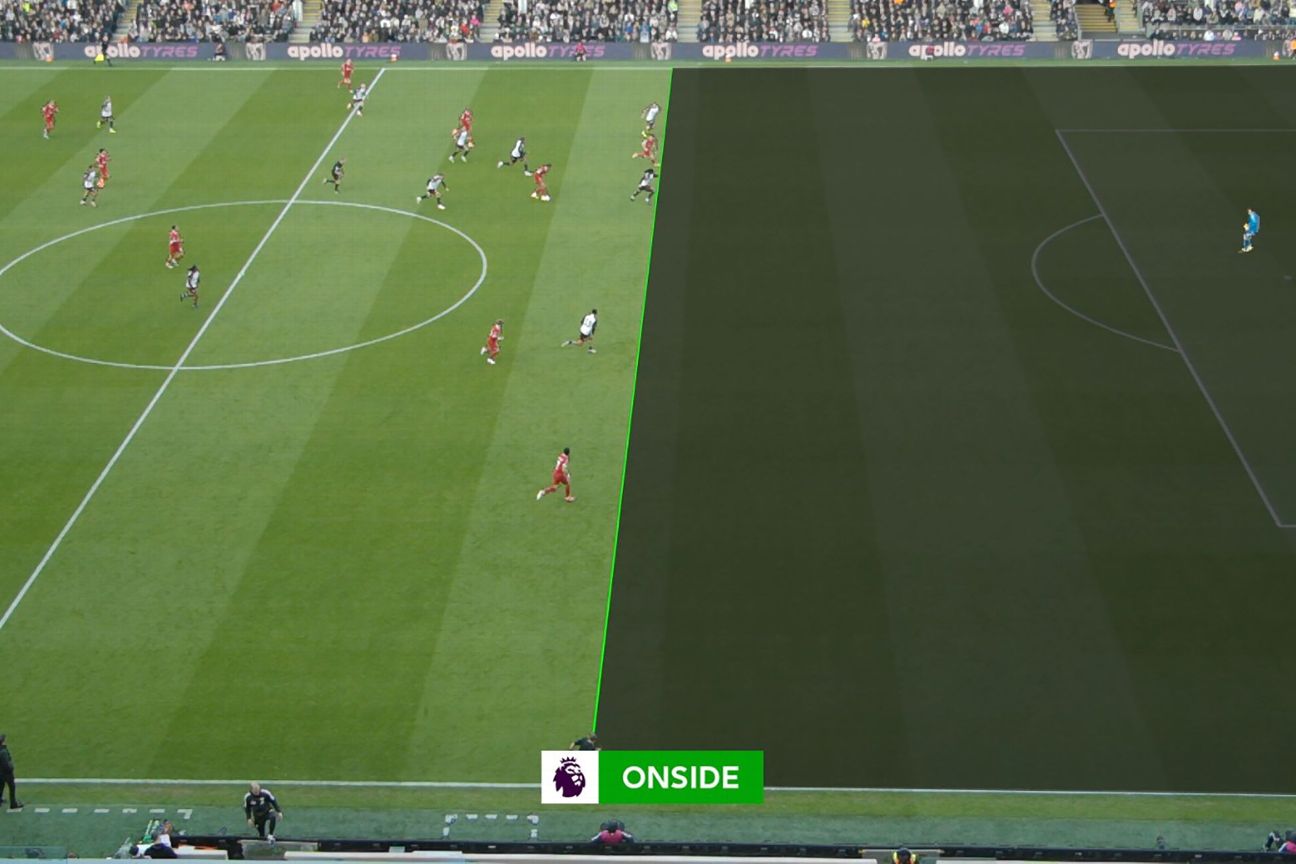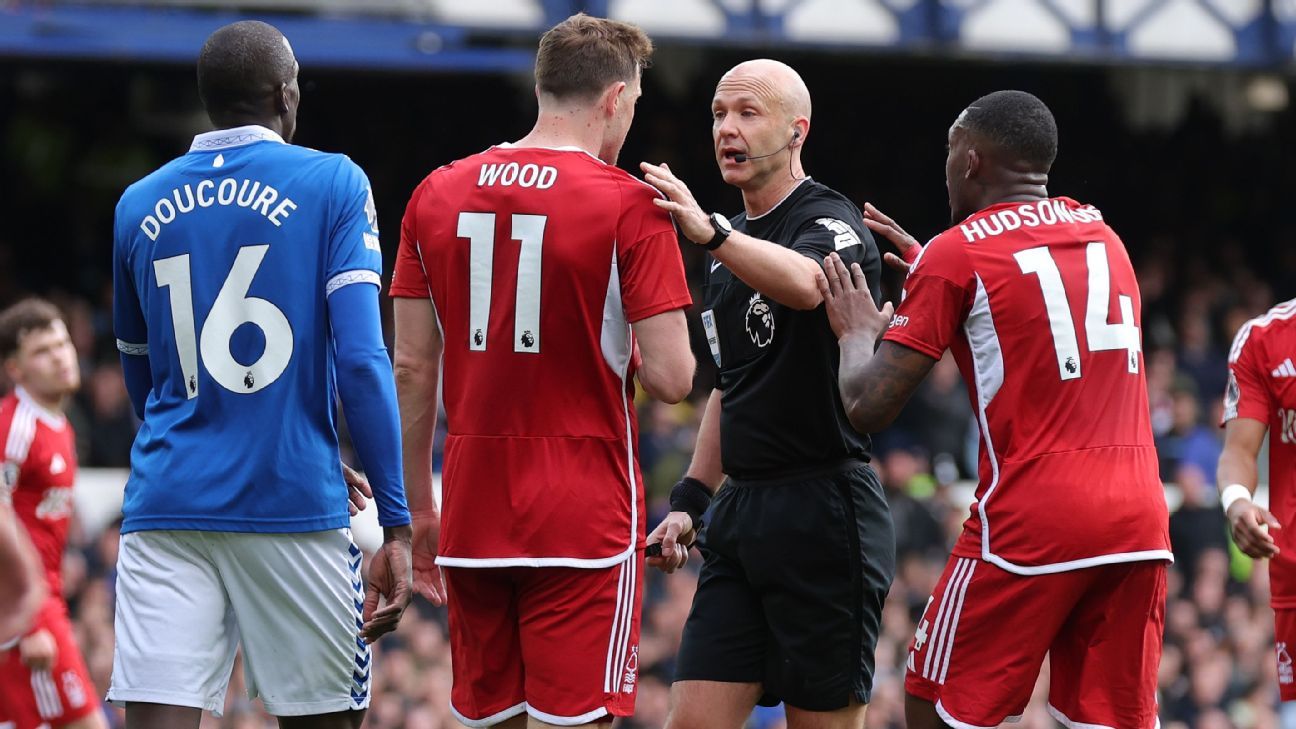Video Assistant Referee causes controversy all the time in the Premier League, and the FA Cup doesn’t escape either. But how are decisions made, and are they correct?
After each weekend we take a look at the major incidents, to examine and explain the process both in terms of VAR protocol and the Laws of the Game.
– How VAR decisions have affected every Prem club in 2023-24
– VAR in the Premier League: Ultimate guide
In this week’s VAR Review: There is only one place to start and it’s with the three penalty appeals which led to Nottingham Forest releasing a remarkable statement on X which called into question the integrity of match officials. But we’ll also look at a contentious handball by Manchester City’s Jack Grealish in the FA Cup semifinal against Chelsea.
Possible penalty: Young challenge on Reyna
What happened: Nottingham Forest were on the attack in the 24th minute when Giovanni Reyna went down inside the area and appealed for a penalty for a foul by Ashley Young. Referee Anthony Taylor waved away the penalty appeals, and it was checked by the VAR, Stuart Attwell.
VAR decision: No penalty.
VAR review: Forest claimed that they had been the subject of “three extremely poor decisions,” yet on the first incident the VAR is never likely to get involved when there’s minimal contact and an exaggerated fall.
There’s plenty of examples of similar situations with the same outcome, all of which have been supported by the Premier League’s Independent Key Match Incidents Panel.
Two examples involved Everton games in recent weeks. Dominic Calvert-Lewin went to ground after light contact from AFC Bournemouth‘s Tyler Adams, and James Garner also fell from a challenge by Burnley‘s Jay Rodríguez — in both cases the VAR ruled that contact wasn’t enough to make the attackers go down as they did.
We have seen several soft penalties given on the field, indeed Everton had their own complaints about spot kicks given to Manchester United, but for the VAR it’s a higher threshold.
Possible penalty: Handball by Young
What happened: For the second incident, the ball was played to the back post and Callum Hudson-Odoi attempted to help it back across the six-yard area. Young had moved across to pressure the Forest player, with the ball coming off him and going behind for a corner kick. Referee Anthony Taylor ignored claims for a penalty for handball, with the ball coming off Young’s arm.
VAR decision: No penalty.
VAR review: It won’t be the last time we touch on handball this week, yet for all the handball drama this season the VAR has only intervened to advise a spot kick six times: Cristian Romero vs. Arsenal, William Saliba vs. Chelsea, Michael Keane vs. Liverpool, Kurt Zouma vs. Everton, Reece Burke vs. Sheffield United, Vinicius Souza vs. Luton Town — and the last two were judged to be incorrect VAR interventions.
Of the four correctly awarded, the player’s arm was clearly away from their body and creating a barrier. The Premier League has tried to leave handball decisions with the referee unless the arm is in a position which truly cannot be justified, a far more lenient approach than in the other major European leagues.
The penalty awarded against Everton defender Keane in the Merseyside derby provides the best comparison: an incident that happened in almost the exact same position on the pitch.
Keane’s arm was away from his body, almost at a 90 degree angle, and was an obvious VAR intervention.
As with the Reyna penalty appeal, it’s the on-field decision which carries the weight, and had referee Taylor given either of these decisions they wouldn’t have been overturned. It explains how Young gets away with the ball hitting his arm, but Manchester United’s Aaron Wan-Bissaka was penalised against Coventry City in the last moments of the FA Cup semifinal when his arm appeared to be closer to his body: in both cases the on-field decision was upheld.
While Wan-Bissaka had his arm away from his body when the ball was played pass across the box, it was closer to his side when ball hit it. Would the VAR have intervened had referee Rob Jones not pointed to the spot? It’s very unlikely.
These two situations perfectly illustrate how VAR’s job isn’t to create consistency, but to evaluate individual decisions for a “clear and obvious” error. The VAR won’t make decisions based on precedent, but on each individual case.
Possible penalty: Young challenge on Hudson-Odoi
What happened: The third incident was when Hudson-Odoi raced onto a through-ball in the 55th minute and was challenged by Young. The Forest midfielder went down under the tackle, but referee Taylor said no penalty, and signalled the shape of the ball to indicate a touch by the defender.
VAR decision: No penalty.
VAR review: Of the three situations this is the one where Forest have a legitimate complaint. The referee’s description of an incident is at the centre of the VAR’s decision-making, so if Taylor thinks Young got the ball and replays suggest he didn’t, surely that qualifies as a clear and obvious error?
It’s not quite that simple, as it still requires the VAR to judge that the error is a missed penalty; a referee isn’t just sent to the monitor to have another look purely if the description doesn’t match. But wrongly thinking a player has won the ball when he’s taken the opponent should qualify.
The Premier League is desperate to limit the impact of VAR upon games, which is why it wants such a high bar for interventions. It wants VAR to go back to it’s original remit of “minimum interference for maximum benefit,” but it hinges on good decisions on the field in the first place.
It’s clearly still affecting the ability of a VAR to do the job efficiently. Of the 28 errors this season, 23 have been because the VAR haven’t stepped in when they should have. This will be a 24th. It’s the apparent reluctance to get involved which is angering clubs more than the original decision.
Young doesn’t get the ball, catches the boot of the Forest player and fouls him — this should have been a penalty.
The high bar is well intentioned but the philosophy falls down if errors are being waved through because it’s hard for those in Stockley Park to know where that high bar is. An eagerness not to re-referee the game means some mistakes are not being corrected, and it’s not improved this season.
Forest were unlucky not to get at least one of the three decisions on the field, and when multiple subjective decisions go against one team it’s understandable there will be frustration.
Yet this doesn’t excuse the tone of Forest’s tweet, sent moments after the full-time whistle. This was a premeditated act, with Forest seemingly ready to act if a decision went against them. Every club is within their rights to complain and highlight refereeing issues, but there are acceptable ways to do it.
Forest said they had “warned the PGMOL that the VAR is a Luton fan before the game but they didn’t change him,” yet no request was made for Attwell to be replaced nor did they lodge a protest against his appointment. Mark Clattenburg, Forest’s refereeing consultant, spoke to Howard Webb, the head of officials in the Premier League, yet he did not raise an issue with Attwell in the VAR hub.
There are valid questions about appointing Attwell, who supports relegation rivals Luton Town, and that controversy would have been avoided had a different referee been used. It gave Forest an opening should anything go against them.
In the past referees have been changed when a possible conflict of interest has been raised. Last season James Bell was due to referee the League One game between Ipswich Town and Charlton Athletic, but it emerged he is a supporter of Sheffield Wednesday, who were Ipswich’s promotion rivals. After a complaint was made, Bell was replaced, yet Forest didn’t go down the same route with Attwell.
Forest were already aggrieved about a series of decisions before Sunday; they have been on the receiving end of half the six missed VAR interventions this calendar year: penalties that should have been awarded against Newcastle United and West Ham United, and a red card which should have been shown to Brighton & Hove Albion‘s Jakub Moder. The VAR wasn’t a Luton fan in either of those games.
Yet on the net score for VAR interventions this season, only Fulham (+5) have a more favourable record that Forest (+4) — though Forest should actually be on +6 (they had a VAR error in their favour which ruled out a late winner for Burnley.)
After the match, Forest boss Nuno Espirito Santo stoked the flames further, saying: “If we were in another country, for sure that [the subject of conspiracy] will come up” — effectively further calling into question the integrity of the officials.
Forest are certain to be charged by the Football Association and can expect a heavy punishment.
Possible penalty: Handball by Grealish
What happened: Chelsea had a free kick in the 56th minute. Cole Palmer attempted the shot, but it went behind, with referee Michael Oliver signalling a goal kick. However, Chelsea’s players protested that the ball had hit the arm of Jack Grealish in the wall, and the decision was checked by the VAR, David Coote.
VAR decision: No penalty.
VAR review: If this incident had happened before the handball law was rewritten a few years ago it probably would have been easier to give as a penalty. Yet today the law is broken down into many sub-clauses and exemptions to guide referees. That means that it’s not only incredibly difficult for the general fan to understand how decisions are made, but referees are also having to take so many factors into account that it can only lead to perceived inconsistencies.
One of the exemptions covers a player who brings their arm into the body and makes contact with the ball. The logic is the player is the process of making their body smaller, so should not be penalised. But even that isn’t straightforward, as a player can still be judged to deliberately handling in bringing the arm in.
By coincidence, Coote was also the VAR for a similar contentious situation. Martin Ødegaard scooped at the ball in his own penalty area in the Premier League game at Liverpool in December, and Coote ruled that the Arsenal midfielder was bringing his arm in rather than handling on purpose.
That was clearly an error, and the Independent Panel ruled that the VAR should have intervened and awarded a spot kick to Liverpool as Ødegaard’s actions couldn’t be considered as bringing the arm into the body.
If Ødegaard was an error, then surely Grealish is too? Perhaps not. Grealish was part of the wall and had his arm on a teammate’s shoulder. As the wall split when the players jumped, his arm came down to his side. It leaves the question of whether the Manchester City player knew what he was doing or if it was the natural movement of the arm as it came down. You can argue either case but Coote has a valid explanation through the exemption.
It feels like it’s more of a penalty than the one awarded to Manchester United at AFC Bournemouth last weekend. Adam Smith had his arm much closer to him, but made a movement towards the ball with his arm coming out to make his body bigger. The Incidents Panel unanimously voted that the penalty was a correct decision.
The Grealish situation is complicated by Oliver not thinking the ball had touched anyone in the wall and awarding the goal kick. Much like the Young tackle on Hudson-Odoi, if the referee hasn’t seen the touch on the arm then surely that in itself is grounds for a review and for them to be sent to the monitor? Coote is taking the incident on its merits, applying menu of considerations and possible exemptions within the law, and deciding if the error meets the threshold for a VAR intervention. Is it any wonder we have so much perceived inconsistency with handball?
To add to the frustration of Chelsea fans, Coote cannot tell a referee to correct their restart decision and give a corner — even though there is a VAR review for the ball touching a Manchester City player.
Possible offside: Wright on Torp goal
What happened: Coventry City thought they had scored an incredible 121st-minute winner against Manchester United, with the Sky Blues fans at Wembley sent into delirium. However, it became clear upon the first replay that Haji Wright may be offside before he set up Victor Torp for the goal.
VAR decision: Goal disallowed.
VAR review: It’s the worst of VAR, the kind of situation which makes it so difficult for fans to get on board — stripping away a fairy-tale moment which would have lived on in the annals of FA Cup history forever. To all intents and purposes it never even happened.
It looked like Wright would be offside by a clear margin when the ball was played forward, yet it was much closer. In fact it was millimetres from the tolerance level, or benefit of the doubt, when the attacking and defensive lines are touching.
The gap between the lines is so small it’s barely noticeable; a single green line would have been displayed if they were touching.
Offside has to start somewhere with technology, and whatever you do there will always be marginal calls.
The graphic was called into question due to the position of the line to defender’s boot, though it’s slightly misleading as the foot was in the air meaning there’s also a vertical line down to the ground, making the blue line appear thicker..

Semi-automated offside technology (SAOT), which will be introduced early into next season, will help with the visualisation of decisions, creating a computer-generated graphic which swings in line with the players and identifies exactly which part of the attacker is offside.
It won’t stop these marginal decisions, and in fact is likely to increase them as the tolerance level — which exists to account for inconsistencies in identifying the kick-point and plot points on the players — is removed.
Italy’s Serie A has seen less general controversy over offside decisions since it introduced SAOT in January 2023, with the frustration reserved for the times the graphic displays a very marginal offside.
Liverpool‘s third goal at Fulham on Sunday provides the perfect example. Diogo Jota broke through the offside trap to score, with the assistant keeping their flag down. The technology produced a single green line, so Jota needed the tolerance level for goal to stand. Next season with SAOT this goal would most likely be disallowed.

Possible red card: Kilman challenge on Havertz
What happened: Max Kilman attempted to challenge Kai Havertz in the 35th minute, but the Arsenal forward got to the ball first. Kilman caught Havertz, with referee Paul Tierney allowing Arsenal to continue with the ball. The Wolverhampton Wanderers captain was booked when play stopped. The VAR, John Brooks, checked for a possible red card.
VAR decision: No red card.
VAR review: There’s been many similar situations, with a tackle being slightly mistimed and contact on the opponent being just above the boot.
It’s a strong challenge by Kilman, but based on the other occasions when the VAR hasn’t intervened, a yellow card is an acceptable on-field decision.
A good comparison is the yellow card shown to Manchester United defender Harry Maguire against Fulham, as he stepped into the challenge with contact around the top of the boot.
Possible offside: Wissa when scoring
What happened: Brentford doubled their lead in first-half stoppage time when Yoane Wissa scored from close range, but was there a case for offside?
VAR decision: Goal stands.
VAR review: From the main broadcast camera it looked as though Wissa might have been marginally in front of the last defender, but the offside lines proved that he was just being played onside by Reece Burke.

Some parts of this article include information provided by the Premier League and PGMOL.
